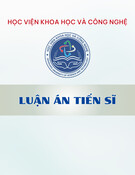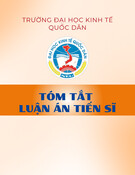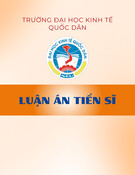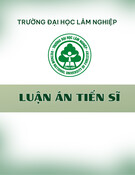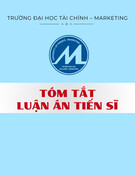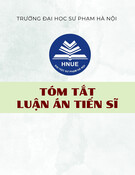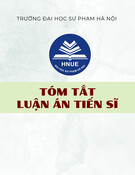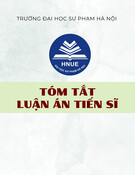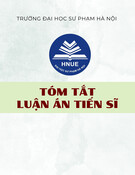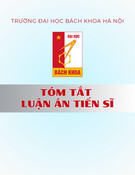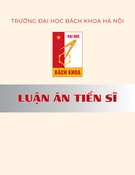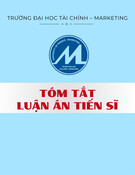VIETNAM ACADEMY OF SCIENCE AND TECHNOLOGY
MINISTRY OF EDUCATION AND TRAINING
GRADUATE UNIVERSITY OF SCIENCE AND TECHNOLOGY -----------------------------
LU NGOC TRAM ANH
PRIMARY SUCCESSION OF MANGROVE FOREST
IN CON ONG TRANG, MUI CA MAU BIOSPHERE RESERVE
Major: Ecology
Code: 9.42.01.20
SUMMARY OF ECOLOGY DOCTORAL THESIS
Ho Chi Minh City – 2020
This work was completed at Graduate University Science and
Technology - Vietnam Academy of Science and Technology
Academic supervisor 1: Assoc. Prof. Dr. Vien Ngoc Nam
Academic supervisor 2: Assoc. Prof. Dr. Nguyen Thi Phuong Thao
Reviewer 1: …………………………….
Reviewer 2: …………………………….
Reviewer 3: …………………………….
The Dotoral thesis will be defended at the Doctoral thesis examination
Board of Graduate University of Science and Technology – Vietnam
Academy of Science and Technology at…. Date …. /……/ 2020.
The thesis can be accessed from:
- The library of Graduate University of Science and Technology
- The National Library of Viet Nam
-1-
GENERAL INFORMATION
1. The importance for doing the thesis
Mangrove forest has ecological, economic and environmental
functions in climate change adaptation and mitigation. This forest also
helps in protecting sea dyke, alluvial soil, preventing erosion, limiting
saline intrusion, regulating local climate, conservating biodiversity. In
addition, this ecosystem plays an important role in developing
ecotourism and education.
Coastline of Viet Nam stretchs from the North to the South with
the rich and diverse mangrove vegetation. Mangrove ecosystem in Ca
Mau province has typical features of this ecosytem in Vietnam and
Southeast Asia. Tran Thi Van et al. (2015) identified that area of
mangrove forest in Ca Mau province decreased from 71.345 ha (1953)
to 33.083 ha (1992), after that rised to 46.712 ha (2011). The reasons
of the area decline due to the toxic chemicals sprayed by the US army
during the war, the land use change from forest land to agriculture and
aquaculture land. The mangrove ecosystem in Mui Ca Mau is mainly
formed from river alluvium. Con Ong Trang belonging to Mui Ca Mau
National Park is a natural alluvial area including three sand dunes
namely Con Trong, Con Ngoai and Con Moi that formed in Cua Lon
river, Ong Trang estuary. This is favorable area for research relating
to impact of natural conditions on mangrove ecosytem because it
formed according to the primary succession without human influence.
Therefore, the research on primary succesion in Con Ong Trang
provide scientific data to mangrove study, scientific basis for planning
of planting and appropriate using mangrove forest. In addition, the
reasearch is great significane for conservation and development of the
-2-
mangrove ecosystem in Con Ong Trang where is the strictly protected
of Mui Ca Mau National Park.
2. Objectives of study
To identify boundaries and area that formed in various periods
of time in Con Ong Trang.
To analyze primary succession of mangrove forest in Con Ong
Trang and suggest the diagram of primary succession in this area.
To determine the distribution of mangrove plant species and
structure of forest, quantitative analysis of plant diversity and calculate
carbon storage in Con Ong Trang; as well as to analyse the impact of
main ecological factors to structure, diversity and distribution of
mangrove plants following space and time periods.
3. Object and scope of the research
Object of the research: mangrove ecosystem in Con Ong Trang.
Research scope: mangrove plant species; criteria on topographic
elevation, tide, soil characteristics; carbon stocks in Con Ong Trang.
4. Main contents of the thesis
4.1. Studying changes in area of mangrove forest in Con Ong
Trang from its inception to the present.
4.2. Investigating species composition, distribution, structure
and diversity of mangrove plants in Con Ong Trang under the effects
of ecological factors.
4.3. Primary succession of mangrove forest in Con Ong Trang.
5. Scientific and practical significance of the thesis
The thesis contributes to the development of theory of primary
succession and provides important data to the research on mangrove
ecosystem.
-3-
The thesis is the scientific background for the management,
planning and selection of appropriate plant species in mangrove
afforestation projects.
CHAPTER 1. LITERATURE REVIEWS
1.1. Mangrove species diversity and mangrove forest structure
Mangrove forest is an ecosystem in which plant species
adapting to coastal and estuarine environments play the key role.
Mangrove plants are divided into two groups: Group of true
mangroves and group of mangrove associates.
The thesis has reviewed the study results relating to: 1)
mangrove species composition, 2) plant diversity in mangrove forest,
3) mangrove forest structure. Southeast Asia was considered to be the
most mangrove plants diverse region with 44 true mangrove species.
There were 35 true mangroves in mangrove flora of Vietnam and they
developed abundantly in the South Coast. The diversity index
fluctuated among study areas. Species belonging Avicennia and
Rhizophora genus usually have the highest IVI value in many regions.
The distribution of number of trees acording to diameter and height
classes were studied by many authors such as Calegario et al. (2015),
Seedo et al. (2017), Nguyen Thi Nguyet and Ho Dac Hoang (2014),
Vien Ngoc Nam et al. (2016) …
1.2. Distribution of mangrove plants
1.2.1. Mangrove distribution of the world
Mangrove forest was found along the tropical and subtropical
coasts, mainly between latitudes 25° North and 25° South (Kauffman
and Donato, 2012)
-4-
1.2.2. Mangrove distribution in Vietnam
Phan Nguyen Hong et al. (1999) divided mangrove forest of
Vietnam into 4 zones. The mangrove at the South Coast has richer
species composition than other zones.
1.2.3. The impact of ecological factors to distribution of mangrove
plants
The mangrove plant distribution depended on various ecological
factors including rainfall, temperature, tide, salinity and soil, … The
number of individuals, number of species and tree size were affected
by temperature and precipitation (Phan Nguyen Hong and Hoang Thi
San, 1993). Tidal inundation was the main factor affecting the
mangrove plant distribution (Giesen et al., 2007). Mangrove forests
might occur on variety of sediments, mud, coral reefs; however, they
grew best on muddy soil. The appropriate salinity for mangrove plants
was about 5 – 30‰ (Lacerda et al., 2001).
1.2.4. Types of mangrove plant distribution
Mangrove plants had two main form of distribution depending
on structure of mangrove community. They are random distribution
and aggregate distribution.
1.3. Carbon accumulation of mangrove forest
Mangroves were one of the most carbon-rich forest types in the
tropics. Carbon accumulation of mangrove forest depended on specie
composition, density, age and height classes, topography. In general,
above ground carbon pools accounted for about 40 – 45% of total
carbon stock and in the root was 30 -75%
-5-
1.4. Mangrove succession
1.4.1. Ecological succession
1.4.1.1. Concept: The view of succession began with Clements’
concept (1961). According to Clements, succession of plants was an
indeterminate chain of change.
1.4.1.2. The causes of succession
Ecological succession was a process that caused by many reason
in which there were some main causes: Changes of natural condition
impact on community in ecosystem; Living activities of community;
Interation among species in community…
1.4.1.3. Classification of succession
Succession was classified into primary succession, secondary
succession and decomposition succession.
1.4.2. Mangrove succession
1.4.2.1. Theory of mangrove succession
The mangrove succession was a unique example of the primary
succession of tropical coastal vegetation, because this ecosystem
changed rapidly over time and in the space of material cycle.
1.4.2.2. Studies in the world
Chen and Twilley (1998) suggested the model of effects of
salinity and soil nutrient content on distribution of three mangrove
plant species. Ball (1980) studied secondary succession of mangrove
forest in the Southern Florida.
1.4.2.3. Studies in Vietnam
Phan Nguyen Hong and Hoang Thi San (1993) built succession
diagram and identified typical species for each stage in various region.
Based on the soil conditions, Phung Trung Ngan and Chau Quang
Hien (1987) stated the primary succession types of mangrove forests
-6-
in Mui Chua (Quang Ninh province), CuaDai, Cua Ham Luong (Ben
Tre province), the coast of Ho Chi Minh city and Ca mau province
(Minh Hai). According to Thai van Trung (1998), the mangrove
succession had three stages with various species composition. The
recent studies showed the replacement of communities following the
changes of environmental and soil conditions in Ca Mau province.
Many authors described the succession mainly based on monitoring
the current distribution status of mangroves and environment status.
However, the relationship between species composition and
environmental factors have not quantitative analyzed. Therefore, it is
essential to have quantitative analysis of succession over the time and
space in the relationship with environmental condition in mangrove
forests.
1.5. Research results on mangrove forest in Con Ong Trang
Con Ong Trang was a region formed according to natural process
without human effects. Therefore, the mangrove ecosystem on the dunes of
Ong Trang estuary was selected for many studies in recent times. There
were several authors have published their works relating to the investigating
species composition of Con Trong or Con Ngoai (Ong Trang estuary, Ca
Mau province), studying factors impacting the vegetation, learning the
principle of forest structure in this area. These studies were carried out in
the recent times from 2007 to 2014 and study area was only Con Trong or
Con Ngoai instead of for all dunes of Ong Trang estuary (belonging to Mui
Ca Mau Biosphere Reserve). There was also not have any research on
primary succession in Con Ong Trang.
-7-
CHAPTER 2. STUDY AREA AND METHODS
2.1. Study area
The study area included three sand dunes namely Con Trong,
Con Ngoai and Con Moi with various forming time. These dunes were
located at Ong Trang estuary, Ngoc Hien district, Ca Mau province).
In the thesis, this area was jointly referred to Con Ong Trang.
2.3. Methods
2.3.1. Methodology: The methodology of this thesis based on: The
view of Thai Van Trung (1998) and methodology of space-for-time
substitution (Walker and Moral, 2003).
2.3.2. The area of regions formed in different time periods in
mangrove forest in Con Ong Trang: Con Ong Trang were divided
into areas forming in different periods of time (Figure 2.4; Table 2.3).
2.3.3. Method of investigating quadrats: In each quadrat, growth
indicators of tree were determined including the scientific name and
morphological characteristics of species; the number of individuals of
each species, diameter at breast height and tree height.
Table 2.3. Number of quadrats in areas of Con Ong Trang Con Moi
Con Trong
Con Ngoai
Formation periods
Areas
Areas
Areas
Before 1962 1962-1979 1979-1992 1992-2004 2004-2016 Total
V_CT IV_CT III_CT II_CT I_CT
No. quadrats 4 12 11 5 11 43
III_CN II_CN I_CN
No. quadrats 20 5 6 31
I_CM
No. quadrats 18 18
2.3.4. Method of species identification: Indentifying scientific name
of species according to morphological comparison method based on
main documents including Cay co Viet Nam (Pham Hoang Ho, 1999-
2003), Rung ngap man Viet Nam (Phan Nguyen Hong et al., 1993),
-8-
Mangroves of the Kien Giang biosphere reserve Vietnam (Norm
Duke, 2012)
2.3.5. Methods of environmental parameters survey, soil collection
and soil characteristics analyse
a. Classification of soil according to Decision 5365/QD-BNN-
TCLN
b. Determination of the tidal regime
c. Soil sampling: Collecting soil samples in two soil layers: 0-
20 cm and 20-60 cm.
d. Measurement of salinity and pH
e. Soil samples analysis with several parameters including
content (%) of nitrogen, phosphorus, potassium, content of carbon and
texture in both soil layers.
2.3.6. Data analysis
2.3.6.1. Softwares used in data analysis included Microsoft
Excel 2016, Statgraphics Centurion XVI., Biodiversity Pro 2.0, Primer
6.1.6
2.3.6.2. The formula for calculation
a. Importance Value Index (IVI): IVI = (RN + RF + RBA)/3
b. Biodiversity indices included the species abundance, the
evenness index, the diversity Shannon Wiener’s index and the
Simpson’s dominance index were calculated using PRIMER 6.1.6
software.
c. Biomass and forest stock, carbon storage Biomass: AGB = 0,251 x ρ x Dbh2,46 (kg);
BGB = 0,199 x ρ0,899 x Dbh2,22 (kg)
Carbon in aboveground biomass: CAGB = 0,47 x AGB
Carbon in belowground biomass:CBGB = 0,39 x BGB
-9-
CHAPTER 3. RESULTS AND DISCUSSION
3.1. The formation of dunes at Ong Trang estuary over time
According to the results of analysis and processing of maps and
satellite images, the area of Con Ong Trang at the time of the survey
(2016) was determined to be 284.21 ha, of which Con Trong was
165.15 ha, Con Ngoai was 84.9 ha and Con Moi was 34.16 ha.
The area of these dunes in periods were calculated, the results
were shown in Table 3.1. In general, the accretion was mainly in the
Northwest direction.
In different time periods, the area of these dunes had increased
trend, but the rate of increase varried due to the accretion (or erosion)
in the region.
3.2. Primary succession in Con Trong
3.2.1. Tidal and soil characteristics in Con Trong
3.2.1.1. Tidal inundation in Con Trong: 20% of the area was
frequently flooded with tides, 40% inundated by low tides while 40%
inundated by medium tides.
3.2.1.2. Soil characteristics in Con Trong: soil was classified
according to texture as well as value of pH, salinity, content of N, P,
K of two soil layers were determined.
3.2.2. Plant diversity and forest structure in Con Trong
3.2.2.1. Mangrove plant species composition in Con Trong
The study identified 10 true mangrove species belonging to 4
families in Con Trong mangrove. In which several species occurred
outside the quadrats including A. ilicifolius, X. moluccensis and R.
mucronata. In addition, a number of regenerated individuals of C.
zippeliana were also found in quadrats.
-10-
3.2.2.2. The importance value indices of mangrove plants in
Con Trong
The two dominant species in Con Trong were R. apiculata and
A. alba. The IVI of R. apiculata was the highest (IVI = 54.98%);
followed by A. alba (IVI = 29.88%).
3.2.3. Mangrove plant distribution in Con Trong
Aggregation was the main distribution types of mangrove plants
in Con Trong (Table 3.8). At the similarity of 40%, A. alba and R.
apiculata were belong to one group. At the 20% level, three species
including A. alba, R. apiculata and B. parviflora were in a group.
3.2.4. Effects of tides and soil charactersistics on mangrove plants
distribution in Con Trong
3.2.4.1. Effects of tides on the mangrove plant distribution in Con
Trong: the results of MDS analysis identified the distribution of dominant
species according to various types of tidal inundation Fig. 3.5.
3.2.4.2. Effects of soil types on the mangrove plant distribution in Con
Trong: The distribution of A. alba and R. apiculata were shown in Fig. 3.6.
3.2.4.3. Effects of soil characteristics on the mangrove plant
distribution in Con Trong
The results of PCA analysis indicated that community in Con Trong
was divided into three groups. With the increasing of salinity but decreasing
of pH and potassium content, the number of R. apiculata increased. While
mixed community (R. apiculata - A. alba) was effected by of
phosphorus content as well as salinity.
3.2.5. The alteration of plant species composition in Con Trong
The IVI of A. alba in newly form areas (2004 – 2016) was the
highest. After that the value declined in following stage of mangrove
-11-
growth. In contrast, IVI of R. apiculata made an increase with forest
age, from 27,23% (2004-2016) up to 79,35% (1962-1979).
3.2.6. The succession of forest structure in Con Trong
The density of mangrove trees in Con Trong gradually dropped
from beginning to the stable mature stage; and the rate of decrease
differed in various stages. Meanwhile, average of tree diameter and
height rised and there were statistically significant differences among
areas.
3.2.7. Carbon accumulation in stages in Con Trong
3.2.7.1. Biomass and carbon stock in Con Trong
The average biomass at the time of survey was 423.43 ± 157.76 t ha-1. The average carbon in aboveground biomass was 140.60 ± 53.78 t ha-1; in belowground biomass was 48.47 ± 16.92 t ha-1.
3.2.7.2. Carbon accumulation in stages in Con Trong
The carbon accumulation increased with forest age from
beginning until the age of 37-54 but went down in following stage.
This was due to the decrease of individual density in community.
3.2.8. Primary succession diagram in Con Trong
Primary succession in Con Trong had three stages (Figure 3.9).
Stage 1 was early stage of succession taking place during first
12 years with several typical environmental characteristics. Most area
was frequently flooded tides, soil was mainly fluid-mud, pH was
neutral (6.12 ± 0.75), salinity was about 31.68 ± 5.5‰. A. alba was
the pioneer species that can spread and developed. Subsequently, R.
apiculata grew mixing with A. alba. Nevertheless, A. alba was the
absolute dominant species in this stage.
In the stage 2 (from 12 to 54 years), the topographic elevation
gradually raised, along with the changes in tidal inundation and soil
-12-
characteristic created favaroble condition for the growth of R.
apiculata. Therefore, R. apiculata formed a mixed comminity with A.
alba and gradually dominates at the end of this period.
Environmental features of area in stage 3 were medium tidal
inundation and soft clay ground. In this stage, R. apiculata together
with B. parviflora formed a mixed community; there were also many
individuals of A. officinalis.
3.3. Primary succession in Con Ngoai
3.3.1. Tidal and soil characteristics in Con Ngoai
3.3.1.1. Tidal inundation in Con Ngoai: 45% of total quadrats
was frequently flooded with tides.
3.3.1.2. Soil characteristics in Con Ngoai: Soil in Con Ngoai
had 4 ground types and in term of texture, 96% of area was clay.
3.3.2. Plant diversity and forest structure in Con Ngoai
3.3.2.1. Mangrove plant species composition in Con Ngoai
There were 8 true mangrove species belonging to 3 families in
Con Ngoai mangrove forest. In which several individuals of N.
fruticans appeared outside the quadrats.
3.3.2.2. The importance value indices of mangrove plants in Con
Ngoai
The IVI value of R. apiculata and A. alba did not significantly
differ, respectively 48.14% and 40.19%; there was no completely
dominant species.
3.3.3. Mangrove plant distribution in Con Ngoai
Mangrove plants in Con Ngoai had two distribution types
including aggregated and random distribution (Table 3.20). The
topographic elevation and tidal inundation were relatively different
-13-
among transects. Therefore, many groups of plants formed in the
corresponding environmental conditions.
3.3.4. Effects of tides and soil charactersistics on mangrove plants
distribution in Con Trong
3.3.4.1. Effects of tides on the mangrove plant distribution in Con
Ngoai: MDS analysis showed the distribution of A. alba, R. apiculata, B.
parviflora in various types of tidal inundation.
3.3.4.2. Effects of soil types on the mangrove plant distribution in Con
Ngoai: A. alba mainly appeared in fluid-mud and R. apiculata distributed in
mud and soft clay.
3.3.4.3. Effects of soil characteristics on the mangrove plant
distribution in Con Ngoai
Mangrove plant communities in Con Ngoai was divided into 3
groups. In which mixed community (R. apiculata-A. alba) grew in
high soil pH areas. The number individual of A. alba was direct ratio
to potassium content.
3.3.5. The alteration of plant species composition in Con Ngoai
There was an alteration of species composition in Con Ngoai
mangrove. While S. alba was only present in the early stage of 1992-
2016, A. officinalis and C. zippeliana appeared later, until the period
1979-1992; B. parviflora and B. cylindrica are also found in 1992-
2004 period. Althouh A. alba and R. apiculata are both present in
growing stages of the forest, IVI value of these two species had various
increase or decrease.
3.3.6. The succession of forest structure in Con Ngoai
The density in areas of Con Ngoai were not statistically
significant different. During the period 1979-1992, the mangrove tree
had a significant increase in diameter and height.
-14-
3.3.7. Carbon accumulation in stages in Con Ngoai
3.3.7.1. Biomass and carbon stock in Con Ngoai
The average carbon in aboveground biomass was 114.57 ±
44.23 t ha-1; in belowground biomass was 40.34 ± 14.50 t ha-1.
3.3.7.2. Carbon accumulation in stages in Con Ngoai
The carbon accumulation was not statistically significant
difference between the first stage and the second stage; carbon stock made a strong increase in the third stage (180.45 ± 52.64 t ha-1).
3.3.8. Primary succession diagram in Con Ngoai
Primary succession in Con Ngoai was presented as following:
Stage 1 took place during early 24 years. In this stage, area was
frequently flooded tides with fluid-mud, soil pH was quite low and
average salinity was 35.59 ± 3.83 ‰. A. alba was dominant species
and there were also individuals of S. alba scattered in the population
of A. alba. In the end of the stage, R. apiculata together with A. alba
formed A. alba – R. apiculata community.
In the second stage, forest age was over 24 years old,
environmental parameters and soil features clearly changed.
Corresponding to the changes of environment, R. apiculata became
dominant species instead of A. alba; these species formed mixed
community.
3.4. Primary succession in Con Moi
3.4.1. Tidal and soil characteristics in Con Moi
The fluid-mud type was not found in Con Moi proving that soil
was rather tight. The proportion of soft clay in Con Moi was 50%.
-15-
3.4.2. Plant diversity and forest structure in Con Moi
3.4.2.1. Mangrove plant species composition in Con Moi
There were 6 true mangrove species belonging to 2 families in
Con Moi mangrove forest. In which several individuals of N A.
ilicifolius appeared outside the quadrats.
3.4.2.2. Plant diversity in Con Moi
The IVI of A. alba was the highest with 75,68% while other
species had very low IVI indicating that A. alba was absolutely
dominant in Con Moi.
3.4.2.3. Mangrove forest structure in Con Moi The average density was 3228 ± 696 tree ha-1, the average
diameter and height were respectively 7.6 ± 4.1 cm and 7.4 ± 2.7 m.
3.4.3. Mangrove plant distribution in Con Moi
The distribution of species namely A. alba, R. apiculata and B.
parviflora were mainly cluster. At the similarity of 40%, R. apiculata
and B. parviflora always distributed together while the rest do not form
any group.
3.4.4. Effects of tides and soil charactersistics on mangrove plants
distribution in Con Moi
3.4.4.1. Effects of tides on the mangrove plant distribution in Con
Moi: The distribution of dominant species according to tidal inundation
were analyzed and presented in Figure 3.21.
3.4.4.2. Effects of soil types on the mangrove plant distribution in
Con Moi: While A. alba could distribute in variety types of soil, R.
apiculata mainly presented in clay soil types.
3.4.4.3. Effects of soil characteristics on the mangrove plant
distribution in Con Moi
-16-
The results of PCA analysis indicated that A. alba adapted to
high salinity and low pH. In contrast, B. parviflora and B. cylindrica
distributed in areas with low salinity and high pH value.
3.4.5. Carbon accumulation in stages in Con Moi
The average carbon in aboveground biomass was 60.33 ± 19.76 t ha-1, accounting for a large proportion of 73%. The average carbon in belowground biomass was 90.19 ± 19.03 t ha-1.
3.5. Primary succession in Con Ong Trang
The three dunes formed in Ong Trang estuary including Con
Trong, Con Ngoai and Con Moi were named as Con Ong Trang.
3.5.1. Tidal and soil characteristics in Con Ong Trang
3.5.1.1. Topographic elevation of Con Ong Trang
Topographic elevation fluctuated from 0.6 to 1.1 m.
3.5.1.2. Tidal inundation in Con Ong Trang
The results showed that 34% of the area was frequently flooded
with tides, 35% inundated by low tides.
3.5.1.3. Soil characteristics in Con Ong Trang
a. Soil types in Con Ong Trang
The solid mud and soft clay had a large proportion in the study
area and the ratio was different among the dunes.
b. Soil texture in Con Ong Trang
The percentage of clay in soil was 39.6 – 59.3%, higher than
ratio of silt or sand.
c. Soil characteristics in Con Ong Trang
Soil pH value measured in this area was in the range of neutral. The
average salinity was 34.85 ± 6.42‰. The average content of nitrogen,
phosphorus and potassium between the two soil layers were not statistically
significant different.
-17-
3.5.2. Plant diversity and forest structure in Con Ong Trang
3.5.2.1. Mangrove plant species composition in Con Ong Trang
Mangrove forest in Con Ong Trang had 11 true mangrove
species belonging to 5 familias. Of which, there were 4 species found
outside the quadrats. The study indicated that a large number of
individuals (52.04% of total individuals) belonged to Rhizophoraceae,
followed by Acanthaceae (46.82%).
3.5.2.2. The importance value indices of mangrove plants in Con Ong
Trang
The two dominant species in Con Ong Trang were A. alba and
R. apiculata. The IVI value of these species were 44.07% and 42.73,
respectively.
3.5.2.3. Diversity indices in Con Ong Trang
The Shannon-Wiener diversity indices varied from 0.38 to 0.6
indicating that the mangrove forests in the study area have low
diversity. The Simpson’s dominance indices ranged from 0.64 to 0.78
proving that there were many dominant species in the communities.
3.5.2.4. Mangrove forest structure in Con Ong Trang
The average density of individuals in Con Ong Trang was 2746
± 887 tree ha-1; however, the tree densities were different among the
dunes.
The curve of N-Dbh distribution had left deviation and number
of individuals was generally in inverse ratio to diameter classes. The
frequency distribution of height was also various in the study area.
3.5.3. Mangrove plant distribution in Con Ong Trang
3.5.3.1. Types of distribution of plant species in Con Ong Trang
Species in Con Ong Trang had two distribution types including
random and aggregated distribution.
-18-
3.5.3.2. Distribution of mangrove species in communities of Con
Ong Trang
The result of similarity coefficient analysis showed that this
coefficient of A. alba and R. apiculata was the highest. At the
similarity of 40%, there was only a group that included R. apiculata
and A. alba; At the similarity of 20%, the species of the mangrove
forest in Con Ong Trang were divided into 3 groups, only S. alba did
not belong to any group.
3.5.4. Effects of tides and soil charactersistics on mangrove plants
distribution in Con Ong Trang
3.5.4.1. Effects of tides on the mangrove plant distribution in
Con Ong Trang
The distribution of species regarding to tidal inundation was
presented as following: A. alba mainly mostly distributed in areas with
frequent flooding and low tide flooding; R. apiculata adapted to areas
with low and medium tidal inundation; B. parviflora mainly
distributed in areas flooded by medium tides.
3.5.4.2. Effects of soil types on the mangrove plant distribution
in Con Ong Trang
A. alba adapted to mud soil; R. apiculata mainly distributed
where ground types were solid mud and soft clay. Soft clay was also
appropriate to the growth of B. parviflora.
3.5.4.3. Effects of soil characteristics on the mangrove plant
distribution in Con Ong Trang
The results of PCA analysis indicated that mixed community of
A. alba and R. apiculata was dominant where soil have high salinity,
low pH value and low content of nitrogen. In contrast, with lower
-19-
salinity as well as higher pH value and %N, mixed community of R.
apiculata and A. alba developed favourably.
3.5.5. The alteration of plant species composition in Con Ong Trang
There was an alteration of species composition in Con Ngoai
mangrove over time. The pioneer species, A. alba, was gradually
replaced by R. apiculata and B. parviflora. Many of mangrove species
also appeared and disappeared in the proccess of succession of the
mangrove forest. From data of three dunes, the research identified IVI
value of species in 5 stages with various time periods (Table 3.44).
3.5.6. The succession of forest structure in Con Ong Trang
The density of individuals tended to decline from the first stage
to later stages; Meanwhile, the average diameter and height made an
increase over time. The frequency distribution of diameter and height
classes in each stage were also calculated.
3.5.7. Carbon accumulation in stages in Con Ong Trang
3.5.7.1. Biomass and carbon stock in Con Ong Trang
a. Biomass of mangrove forest in Con Ong Trang The total biomas in the study area ranged from 186.99 t ha-1 to 423.43 t ha -1. Belowground biomass was less than aboveground
biomass. In addition, aboveground biomass in the dunes was different.
b. Carbon in biomass of mangrove plants: Carbon in
aboveground biomass was 73 – 74% of total carbon in biomass. The
amount of carbon in biomass also differed among study areas.
c. Carbon accumulation in soil until 60 cm depth Soil carbon was 41.292 ± 12.14 t ha-1 in soil layer 0 – 20 cm and
80.978 ± 26.31 t ha-1 in soil layer 20 – 60 cm.
-20-
d. Carbon stock in carbon pools
Carbon stock in carbon pools was high in areas that formed
earlier; the trend of increase and decrease was uneven and different
depending on various pools (Figure 3.42). Carbon stock in biomass
rose faster than soil carbon.
3.5.7.2. Carbon accumulation in stages in Con Ong Trang
The carbon stock varied in different stages. In general, there was
not statistically significant differences between the first two stage;
However, carbon stock increased in later stage (1979 – 1992) and
reached a highest value in period 1962 – 1979. The last stage when
forest age was the highest, the carbon stock declined.
3.5.8. Primary succession diagram in Con Trong
The primary succession in Con Ong Trang was presented as
following:
Stage 1 was the first period of mangrove forest, it occurred until 12th year of the mangrove. In this stage, A. alba scattered to and seized
the newly area which was frequent flooded tides with fluid-mud, low
pH value and high salinity. This was favourable condition for
development and regeneration of A. alba. In addition, there were
individuals of S. alba also distributed randomly in the community. At
the end of period, there were the presence of R. apiculata in the
community.
The second stage was in the range of forest age from 12 to 54
years old. The elevation of the dunes gradually raised, environment
also changed. The area was mainly flooded by low tides; ground
became tight with solid mud having the large proportion, soil pH value
increase while salinity decrease. These changes help species including
R. apiculata and B. parviflora grow and penetrate into the population
-21-
of A. alba. In the end of the period, the ground only flooded by
medium tides with soft clay soil; therefore, the dominance of R.
apiculata was greatly higher compared to A. alba.
Stage 3 began when mangrove forest formed over 54 years. In
this period, the area was only flooded by medium tides, the type of soil
was mainly soft clay, value of pH was about 6.91 ± 1.06, average
salinity was 31.88 ± 2.10‰. While A. alba was absent, R. apiculata
and B. parviflora mixed together. In the mixed community, there was
appearance of A. officinalis.
Figure 3.44. Primary succession in Con Ong Trang
-22-
CONCLUSION AND SUGGESTION
1. Conclusion
The dunes at Ong Trang estuary including Con Trong, Con
Ngoai and Con Moi were named Con Ong Trang. The data analysis of
map and satellite images indentified different areas of the dunes which
formed in different time periods. There were five areas in Con Trong,
3 areas in Con Ngoai and only one area in Con Moi. The primary
succession of the mangroves in the dunes took place in different stages
with various features.
The three stages of primary succession in Con Ong Trang were
analyzed. Specifically, the alteration of mangrove structure and
species composition in corresponding to the variation of ecological
factors including topographic elevation, tidal inundation, soil types
and other soil characteristics were identified. Addition to the changes
of dominant species, there were many mangrove plant species also
appeared and disappeared in stages of the succession in Con Ong Trang.
The mangrove structure, the diversity and distribution of plant
species as well as the carbon stock in Con Ong Trang changed over
time and were affected by environmental factors.
2. Suggestion
- Locating permanent plots for long-term data collection and
monitoring
- Increasing the number of soil samples for analyzing the content
of N, P, K, collecting soil samples in deeper layers, studying the
carbon stock in litter and dead trees.
- Monitoring other environmental factors including temperature,
precipitation and flow of Cua Lon river.
- Studying the regeneration of mangroves.
-23-
CONTRIBUTIONS OF THE THESIS
The thesis identified the areas of Con Ong Trang formed in
different periods corresponding to the stages of succession process.
The thesis analyzed the formation and features of the mangrove
forest in Con Ong Trang in the relation to the habitat including tidal
regime, topographic elevation and soil characteristics. On that basis,
the primary succession of the mangrove forest in Con Ong Trang was
simulated in accordance with the variation of ecological factors.
The thesis contributed to scientific data on the mangrove
ecology in Con Ong Trang including characteristics of environmental
and soil factors as well as the effects of these factors to the distribution
of mangrove species and communities; the plant diversity and
mangrove structure in three dunes in various forming periods; the
biomass and carbon stock of Con Ong Trang over time.
-24-
LIST OF PUBLICATIONS RELATING THE THESIS
1. Lu Ngoc Tram Anh, Vo Hoang Anh Tuan, Vien Ngoc Nam
(2017), Carbon accumulation of mangrove in Con Trong, Mui Ca Mau
National Park in periods of time, Science and Technology Journal of
Agriculture and Rural Development, 321, 143-148.
2. Lu Ngoc Tram Anh, Vo Hoang Anh Tuan, Vien Ngoc Nam
(2017), Soil carbon accumulation of mangroves in Con Ngoai, Mui Ca
Mau National Park, Journal of Forest and Environment, 83, 38-41.
3. Lu Ngoc Tram Anh, Vo Hoang Anh Tuan, Vien Ngoc Nam,
Nguyen Thi Hai Ly, Nguyen Phan Minh Trung (2017), Initial data on
carbon accumulation in biomass of mangroves at Con Ngoai, Ngoc Hien district, Ca Mau province, Proceeding of the 7th National
Scientific Conference on Ecology and Biological Resources, 1539- 1543.
4. Lu Ngoc Tram Anh, Vien Ngoc Nam, Duong Duc Thanh
(2017), Mangrove species distribution in Con Ngoai, Ngoc Hien
district, Ca Mau province, Proceedings of the third international
Conference on Estuarine Coastal and Shefl Studies - ECSS-2017, 474-
482.
5. Lu Ngoc Tram Anh, Vien Ngoc Nam, Nguyen Thi Phuong
Thao, Nguyen Thi Hai Ly (2018), The effects of soil characteristics
on mangrove species distribution at Con Trong, Ong estuary, Ngoc
Hien district, Ca Mau province, Can Tho University Journal of
Science, 54, 75-80.


